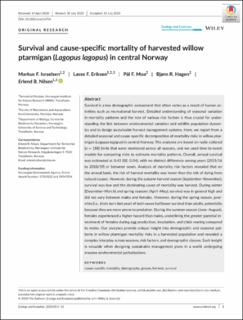| dc.description.abstract | Survival is a key demographic component that often varies as a result of human activities such as recreational harvest. Detailed understanding of seasonal variation in mortality patterns and the role of various risk factors is thus crucial for understanding the link between environmental variation and wildlife population dynamics and to design sustainable harvest management systems. Here, we report from a detailed seasonal and cause-specific decomposition of mortality risks in willow ptarmigan (Lagopus lagopus) in central Norway. The analyses are based on radio-collared (n = 188) birds that were monitored across all seasons, and we used time-to-event models for competing risks to estimate mortality patterns. Overall, annual survival was estimated at 0.43 (SE: 0.04), with no distinct difference among years (2015/16 to 2018/19) or between sexes. Analysis of mortality risk factors revealed that on the annual basis, the risk of harvest mortality was lower than the risk of dying from natural causes. However, during the autumn harvest season (September–November), survival was low and the dominating cause of mortality was harvest. During winter (December–March) and spring seasons (April–May), survival was in general high and did not vary between males and females. However, during the spring season, juveniles (i.e., birds born last year) of both sexes had lower survival than adults, potentially because they are more prone to predation. During the summer season (June–August), females experienced a higher hazard than males, underlining the greater parental investment of females during egg production, incubation, and chick rearing compared to males. Our analyses provide unique insight into demographic and seasonal patterns in willow ptarmigan mortality risks in a harvested population and revealed a complex interplay across seasons, risk factors, and demographic classes. Such insight is valuable when designing sustainable management plans in a world undergoing massive environmental perturbations. cause-specific mortality, demography, grouse, harvest, survival | en_US |

